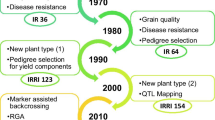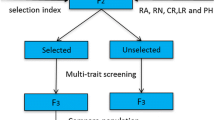Abstract
A plant breeding program is a long-term investment. Therefore, periodic assessment of the effectiveness of a breeding strategy is essential to maximize genetic gains per unit of time and resource invested. In this work, we assessed the effectiveness of the early-generation testing (EGT) approach used in the upland rice (Oryza sativa L.) breeding program at Embrapa (Brazilian Agricultural Research Corporation), Brazil, estimating the genetic progress achieved for three traits in two distinct phases, spanning 15 years. In the first phase (from 2003 to 2010), it was used the bulk method within F3 progenies with prior testing of F2 crosses, while in the second phase (from 2010 to 2017), it was used the bulk method within F2 progenies. The dataset comprised 70 yield trials, involving 1884 F3:5 progenies (phase I) and 925 F2:4 progenies (phase II) from an elite population, and 10 check cultivars, evaluated for grain yield (GY), plant height (PH) and days to flowering (DTF). For estimating the genetic gain, we adapted a generalized linear regression method to compute bi-segmented linear regression coefficients. Desirable genetic gains were achieved only for GY in both phases of the breeding program, with 78.75 kg ha−1 year−1 (2.68%) in the first phase, and 53.78 kg ha−1 year−1 (1.54%) in the second phase. These results show the effectiveness of EGT, especially via bulk method within F3 progenies with prior testing of F2 crosses, applied to upland rice breeding. Some refinements are discussed in the method to make it more cost-effective and more efficient in achieving genetic gains.



Similar content being viewed by others
Abbreviations
- BLUE:
-
Best linear unbiased estimator
- BLUP:
-
Best linear unbiased predictor
- DTF:
-
Days to flowering
- Embrapa:
-
Brazilian Agricultural Research Corporation
- GY:
-
Grain yield
- PH:
-
Plant height
- REML:
-
Restricted maximum likelihood
- EGT:
-
Early-generation testing
References
Bernardo R (1992) Retention of genetically superior lines during early-generation testcrossing of maize. Crop Sci 32:933–937. https://doi.org/10.2135/cropsci1992.0011183X003200040019x
Bernardo R (2003a) On the effectiveness of early generation selection in self-pollinated crops. Crop Sci 43:1558–1560. https://doi.org/10.2135/cropsci2003.1558
Bernardo R (2003b) Parental selection, number of breeding populations, and size of each population in inbred development. Theor Appl Genet 107:1252–1256. https://doi.org/10.1007/s00122-003-1375-0
Bernardo R (2010) Breeding for quantitative traits in plants, 2nd edn. Stemma Press, Woodbury
Borges V, Soares AA, Resende MDV, Reis MS, Cornélio VMO, Soares PC (2009) Genetic progress for the upland rice breeding program in Minas Gerais using mixed models methodology. Rev Bras Biom 27:478–490
Breseghello F, Morais OP, Rangel PHN (1998) A new method to estimate genetic gain in annual crops. Genet Mol Biol 21:551–555. https://doi.org/10.1590/S1415-47571998000400024
Breseghello F, Morais OP, Castro EM, Prabhu AS, Bassinello PZ, Pereira JA, Utumi MM, Ferreira ME, Soares AA (2009) Recurrent selection resulted in rapid genetic gain for upland rice in Brazil. Int Rice Res Newsl 34:1–4. https://doi.org/10.3860/irrn.v34i0.1069
Breseghello F, Morais OP, Pinheiro PV, Silva ACS, Castro EM, Guimarães ÉP, Castro AP, Pereira JA, Lopes AM, Utumi MM (2011) Results of 25 years of upland rice breeding in Brazil. Crop Sci 51:914–923. https://doi.org/10.2135/cropsci2010.06.0325
Cockerham CC (1963) Estimation of genetic variances. In: Hanson WD, Robinson HF (eds) Statistical genetics and plant breeding. National Academy of Science, Washington, pp 53–94
Colombari Filho JM, Resende MDV, Morais OP, Castro AP, Guimarães ÉP, Pereira JA, Utumi MM, Breseghello F (2013) Upland rice breeding in Brazil: a genotypic evaluation simultaneous for stability, adaptability and grain yield. Euphytica 192:117–129. https://doi.org/10.1007/s10681-013-0922-2
Duarte JB (2000) Application and statistical analysis of augmented block design in plant breeding. Thesis, University of São Paulo, Escola superior de agricultura Luiz de Queiroz. https://doi.org/10.11606/t.11.2000.tde-28022002-100846
Falconer DS (1952) The problem of environment and selection. Am Nat 86:293–298
Falconer DS, Mackay TFC (1996) Introduction to quantitative genetics, 4th edn. Pearson Education Limited, England
Federer WT (1961) Augmented designs with one-way elimination of heterogeneity. Biometrics 17:447–473
Fehr WR (1993) Principles of cultivar development: theory and technique. Iowa State University, Ames, pp 172–198
Frey KJ (1954) The use of F2 lines in predicting the performance of F3 selections in two barley crosses. Agron J 46:541–544
Guimarães EP (2009) Rice breeding. In: Carena MJ (ed) Cereals. Springer Science and Business Media, New York, p 3
Hallauer AR, Carena MJ, Miranda Filho JB (2010) Quantitative genetics in maize breeding. Springer, New York
Hartley HO (1950) The use of range in analysis of variance. Biometrika 37:271–280. https://doi.org/10.1093/biomet/37.3-4.271
Li JY, Wang J, Zeigler RS (2014) The 3,000 rice genomes project: new opportunities and challenges for future rice research. GigaScience 3:1–3. https://doi.org/10.1186/2047-217X-3-8
Martínez CP, Torres EA, Chatel M et al (2014) Rice Breeding in Latin America. In: Janick J (ed) (org) Plant Breeding Reviews. Wiley, New York, pp 187–277. https://doi.org/10.1002/9781118916865.ch05
Morais Júnior OP, Melo PGS, Morais OP, Castro AP, Breseghello F, Utumi MM, Pereira JA, Wruck FJ, Colombari Filho JM (2015) Genetic progress after cycles of upland rice recurrent selection. Sci Agric 72:297–305. https://doi.org/10.1590/0103-9016-2014-0137
Morais Júnior OP, Breseghello F, Duarte JB, Morais OP, Rangel PHN, Coelho ASG (2017) Effectiveness of recurrent selection in irrigated rice breeding. Crop Sci 57:3043–3058. https://doi.org/10.2135/cropsci2017.05.0276
Morais OP, Rangel PHN, Fagundes PRR, Castro EM, Neves PCF, Cutrim VA, Prabhu AS, Brodani C, Magalhães Júnior AM (2006) Melhoramento genético. In: Santos AB, Stone LF, Vieira NRS (eds) A cultura do arroz no Brasil. Embrapa Arroz e Feijão, Santo Antônio de Goiás, pp 97–116
R Core Team (2017) R: A language and environment for statistical computing. R Foundation for Statistical Computing, Vienna, Austria. https://www.r-project.org/
Rangel PHN, Morais OP, Zimmermann FJP (2002) Grain yield gains in three recurrent selection cycles in the CNA-IRAT 4 irrigated rice population. Crop Breed Appl Biotechnol 2:369–374. https://doi.org/10.12702/1984-7033.v02n03a07
Resende MDV, Duarte JB (2007) Precision and quality control in cultivar trials. Pesqui Agropecu Trop 37:182–194
Souza MA, Morais OP, Herán REC, Cargnin A, Pimentel AJB (2007) Genetic progress of upland rice between 1950 and 2001. Pesqui Agropecu Bras 42:371–376. https://doi.org/10.1590/S0100-204X2007000300010
van Ginkel M, Ortiz RR (2018) Cross the best with the best, and select the best: HELP in breeding selfing crop. Crop Sci 58:1–14. https://doi.org/10.2135/cropsci2017.05.0270
Yang RC (2009) When is early generation selection effective in self-pollinated crops? Crop Sci 49:2065–2070. https://doi.org/10.2135/cropsci2009.01.0029
Acknowledgements
The authors dedicate this article to the memory of Dr. Orlando Peixoto de Morais, an outstanding scientist and recognized mentor of the rice breeding team at Embrapa. We thank the entire rice breeding staff at Embrapa, especially the research assistants and field workers, and thank Capes (Organ of the Brazilian Ministry of Education), for granting a scholarship to the first two authors.
Author information
Authors and Affiliations
Corresponding author
Additional information
This article is dedicated in memoriam to O. P. Morais.
Rights and permissions
About this article
Cite this article
Barros, M.S., Morais Júnior, O.P., Melo, P.G.S. et al. Effectiveness of early-generation testing applied to upland rice breeding. Euphytica 214, 61 (2018). https://doi.org/10.1007/s10681-018-2145-z
Received:
Accepted:
Published:
DOI: https://doi.org/10.1007/s10681-018-2145-z




